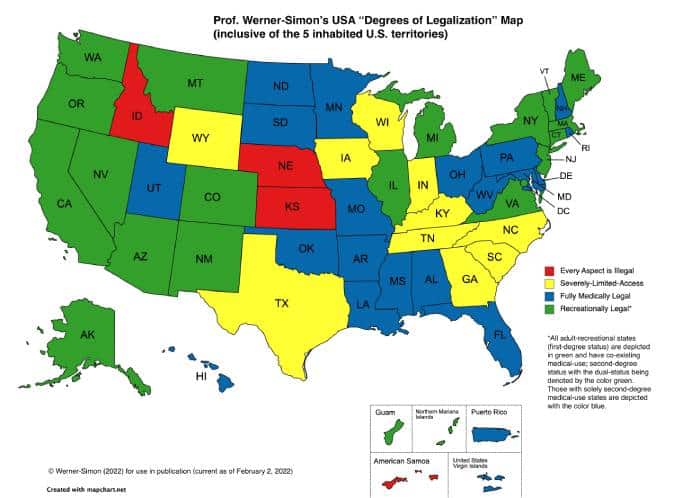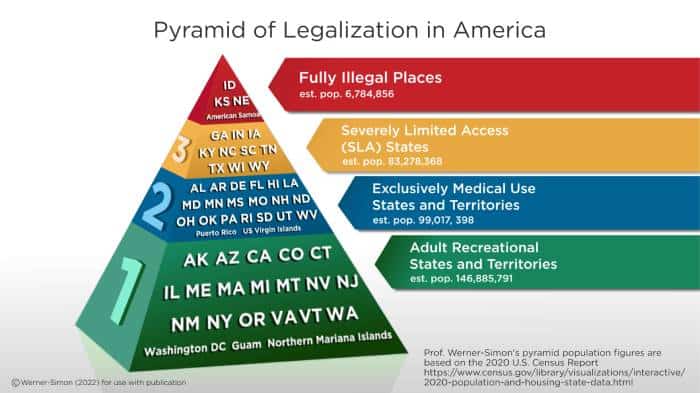Pennsylvania Senate Committee Weighs Cannabis Mistakes, Successes Elsewhere
Marijuana Industry News March 1, 2022 MJ Shareholders
We are deep into the first quarter of the new year, and federal legalization of cannabis remains a pipe dream, an ambition located further into the imaginable future than it seemed a year ago. 2021 was called a cannabis “nothing burger” by Forbes Magazine in its own year-end reflection on the federal cannabis legalization movement, which aptly describes the federal inactivity of last year.
Federal action was initially thought by some to happen quickly after the November 2020 watershed election which brought feather-thin Democratic margins in the U.S. Congress and in which five states (all over the geographic and political map) saw cannabis legalization efforts pass with healthy voter margins.
But with the world entering year three of a global pandemic, Russia invading the country of Ukraine, and Americans bickering about mask mandates, federal cannabis legalization has had to take a backseat to other major issues in the crosshairs of the Biden administration. Even though the U.S. House of Representatives at the beginning of February 2022 “advanced” provisions of the SAFE Banking Act (which would permit access to banking by cannabis businesses). That bill, like the previous SAFE banking bills, is expected to go nowhere in the U.S. Senate, however. This latest vote was the sixth such passage of the SAFE Banking Act in the House.
Has the Lack of Federal Legalization Impacted the Market?
This stymied and stalemated federal impasse is now obvious to cannabis multistate operators and M&A specialists. Federal legalization fervor has waned and is reflected in the market. Cannabis stock prices (once soaring) took significant hits in 2021.
However, a downturn in stock value or performance does not tell an industry’s whole financial story. Brad Sodowick, a finance professor at Drexel University’s LeBow School of Business, and who teaches the “Emerging Business of Cannabis,” explained that “the failure to federally legalize is but one factor to be considered when investing in publicly traded cannabis companies. Many other variables are in play as investment in cannabis has always been risky. Thoughtful investment in this industry requires a long-term, multiyear strategy.”
Sodowick’s strategy pointers also include looking at cannabis sales. He forecasts that “marijuana sales in legal states will continue to grow exponentially in 2022 and beyond.”
These growth predictions are not implausible as cannabis access is expanding across America.
Legalization Action Is in the States—Not the Feds
Legalization remains the province of the states. Currently, there are three degrees of legalization in America. This includes four of America’s inhabited territories in the Atlantic Ocean, (Puerto Rico and the U.S. Virgin Islands (USVI)) and in the Pacific Ocean, (Guam and the Commonwealth of the Northern Mariana Islands (CNMI)).
The three degrees of legalization include:
- Third-degree states include those in which a state’s legislature has passed a law that grants limited access (and often with low or negligible THC content). Georgia passed such a severely-limited-access (SLA) law in 2015, called “Hayleigh’s Hope Act” named for a young child, Hayleigh, who suffered from a debilitating seizure disorder. South Carolina’s SLA law was passed in 2014 and is named “Julian’s Law,” after a brain-damaged South Carolina infant who developed epilepsy, and who had to leave the state to travel to a legal state (Colorado) to treat the 60 seizures that were racking the child’s body. Other third-degree SLA states restrict not just the composition of the product and its medical uses, but also the manner of ingestion, the places where the product can be administered or acquired, and sometimes limit restricted access solely to research studies or institutions. The third-degree states are depicted in yellow on the legalization map.

Mississippi Changes (Finally) Into a Second-Degree Medical State
The most recent evolution from a third-degree limited access state to a second-degree medical use state happened this month in Mississippi.
On Feb. 2, 2022, Mississippi Gov. Tate Reeves, a Republican elected in 2019, signed medical use (second-degree) legislation into law. This ended an almost 15-month stalemate between Mississippi voters and their lawmakers.
Mississippi’s new medical marijuana law places the power to add medical conditions and to issue medical marijuana licenses and registrations to the Mississippi Department of Health. The medical conditions listed on the state Department of Health website which qualify for medical marijuana include cancer, Parkinson’s, ALS, PTSD, AIDS/HIV and autism as well as other conditions associated with terminal or debilitating illnesses such as end-of-life “wasting” disease.
The Mississippi Health Department expects to issue licenses to cultivation facilities, processing facilities, testing facilities, waste disposal and transportation entities within 120 days. Within 150 days, the department reports that it is expected to issue licenses to Mississippi medical marijuana dispensaries.
Other SLA States Are Considering Changes in Legalization
Other severely-limited-access third-degree states are considering advancing to medical marijuana legalization. These include South Carolina and Kentucky.
South Carolina
In February 2022, South Carolina’s State Senate approved a medical marijuana bill, with a 28-15 vote. The approval sends the South Carolina Compassionate Care Act to the South Carolina House of Representatives for consideration. If approved (and then signed by South Carolina’s governor), the legislation in its current form would legalize the use of medical cannabis only in oil, creams, gummies, and edibles, and would prohibit all use in any smokable or combustible dry form.
Kentucky
Kentucky, a severely-limited-access state which permits CBD product for research , is making some moves to break away from the limited access pack of states.
Legislators there, in February 2022, proposed a number of marijuana bills which would legalize adult-use and medical cannabis. The Kentucky Democrats’ proposal unveiled in both chambers on Feb. 17, 2022, is called the “LETT’s Grow Bill” (shorthand for Legalize, Expunge, Treat & Tax).
The Republican counterproposal endorses only medical cannabis, requiring certification of medical conditions by licensed medical professionals. Under the Republican proposal, at-home cultivation and the smoking of the medical cannabis would remain illegal.
In December 2021, Kentucky Governor Andy Beshear (as reported by Kentucky’s Channel 44 News) stated that “Kentucky should definitely move forward with medical marijuana” and that “the law change would allow people who might otherwise turn to more damaging substances to use the drug.”
Even Exclusively Medical States Are “Making Moves” to Legalize Adult-Use Sales
In states such as Ohio, Missouri, Arkansas, South Dakota, and Oklahoma, pro-reform forces have been taking action to ensure that adult-use ballot initiatives are placed on each state’s November 2022 ballot.
U.S. Rep. Tim Ryan of Ohio, at a stop-over in Southern California on Feb. 14, 2022, stated that Ohio (a medical-legal state since 2016) was expected to have adult-use legalization on the November 2022 ballot, which, he surmised, might bring out the college-age voters.
Other medical-legal states, including Delaware, Minnesota, New Hampshire, Hawaii, and Rhode Island, at this time, have members of those state’s legislatures proposing and advancing adult-use cannabis legalization.
And for states that use the referendum process like Maryland (in which the legislature places questions on the ballot for the voters to weigh in on) there too, lawmakers are close to placing adult-use referenda on the November 2022 ballot.
The Remaining Three Fully Illegal States
As of publication, 18 states are first-degree states having legalized adult-use sales with all having co-existing medical regimes.
19 states have legalized exclusively medical use (second-degree). Ten others (third-degree states) have just severely-limited-access. This computation (totaling 47 states) leaves just three mainland states where under state law; marijuana remains “entirely illegal.”
The fully illegal states are Idaho, Kansas, and Nebraska.
Idaho’s Office of Drug Policy current website states: “Marijuana is the most commonly used illicit drug in the United States.” It is “a Schedule I controlled substance under Idaho law” and “is illegal to use.”
Kansas, in 2012, passed legislation that increased penalties for drug crimes including those involving the Kansas controlled substance of marijuana.
And even though the state of Nebraska reduced possession of an ounce or less of cannabis to an infraction offense, distribution of any amount remains a criminal offense punishable by imprisonment and other penalties under Nebraska law.
But these anti-states are considering moves toward some degree of legalization.
Idaho is dipping a toe into the severely limited access (third-degree) status with the Idaho House passing a bill to permit cannabis as a topical pain relief ingredient.
In Kansas, in May 2021, the Kansas House of Representatives passed a medical marijuana bill, and sent it to a committee of the Kansas State Senate for consideration. State Senate hearings have not yet occurred, and the bill has been directed to a different Kansas State Senate panel.
Nebraskans for Medical Marijuana (and other advocacy groups) are raising money and gathering signatures to have legalization of marijuana initiatives placed on the November 2022 ballot.
99% of Americans Live in a Region With Some Degree of Legalization
The U.S. has about 330 million inhabitants. Almost 99% of America’s inhabitants live in a place with some degree of legalization as reflected in this pyramid of legalization.

The pyramid shows that of those 330 million, fewer than seven million live in places where marijuana is illegal under the law of the state.
States Are Leading the Way. Do Your Homework and Stake Your Claim
The legalization action for the near future (meaning, at a minimum, until after the 2024 presidential election) will be occurring in the states.
As a result, those seeking to start, diversify or invest in a cannabis business—should consider the laws, regulations, and practices of the states (and U.S. territories).
The year 2022 will see more states come into the legalization fold – at least to some degree. With the laws (at the state and local level) changing almost weekly, operators would be well-advised to put a marijuana legalization expert on the payroll and find a state climate (figuratively and literally) that fits the bill.
———————————————————————————————————-
Julie A. Werner-Simon, a former federal prosecutor, teaches cannabis law at University of Southern California’s Gould School of Law and Drexel University’s Kline School of Law. She is also a legal analyst in the Emerging Business of Cannabis, a course at Drexel’s LeBow School of Business.
MJ Shareholders
MJShareholders.com is the largest dedicated financial network and leading corporate communications firm serving the legal cannabis industry. Our network aims to connect public marijuana companies with these focused cannabis audiences across the US and Canada that are critical for growth: Short and long term cannabis investors Active funding sources Mainstream media Business leaders Cannabis consumers








